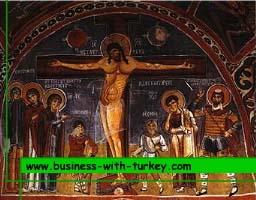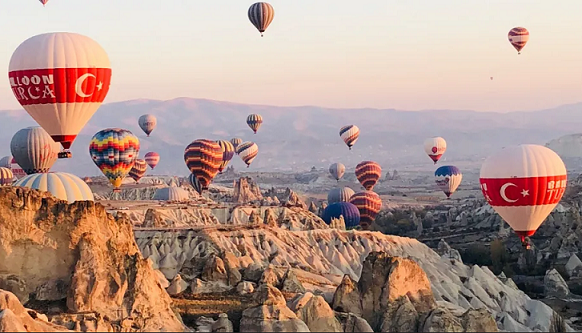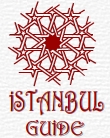|
Goreme
 The
tuff of the region was not only utilized as physical shelters, but also
spiritual . The valley of Goreme is known for its proliferation of churches
carved into the rocks. Built between the 7th and 13th century, at its
height Goreme is said to have had a church for every day of the year.
It is not just the use of the stone that is so fascinating, but the
interior design. Vividly preserved during the ensuing centuries, the
original frescoes celebrate the beliefs of the early Christians. The
only light that permeates the churches is the natural light that is
filtered through the entrance. From a far looking you will only notice
something like shells of vacant windows at the hillside. Most of the
churches are quite small. The dominant layout of the interior chambers
is based on a cruciform design. The most famous churches are located
inside the "open-air museum" of Goreme, they are : The
tuff of the region was not only utilized as physical shelters, but also
spiritual . The valley of Goreme is known for its proliferation of churches
carved into the rocks. Built between the 7th and 13th century, at its
height Goreme is said to have had a church for every day of the year.
It is not just the use of the stone that is so fascinating, but the
interior design. Vividly preserved during the ensuing centuries, the
original frescoes celebrate the beliefs of the early Christians. The
only light that permeates the churches is the natural light that is
filtered through the entrance. From a far looking you will only notice
something like shells of vacant windows at the hillside. Most of the
churches are quite small. The dominant layout of the interior chambers
is based on a cruciform design. The most famous churches are located
inside the "open-air museum" of Goreme, they are :
 Elmali:
This church is dated to the 11th century. The yellow ochre of the region
dominates the frescoes that decorate the vaulted, cross shaped interior.
As with many other Cappadocia churches, peeling paint often reveals
the red as the Christian symbols of the iconoclastic period. The themes
of the frescoes mainly relate to the Christ cycle. Elma in Turkish means
apple. Elmali:
This church is dated to the 11th century. The yellow ochre of the region
dominates the frescoes that decorate the vaulted, cross shaped interior.
As with many other Cappadocia churches, peeling paint often reveals
the red as the Christian symbols of the iconoclastic period. The themes
of the frescoes mainly relate to the Christ cycle. Elma in Turkish means
apple.
Carikli: Named after the carik-shoe marks on the
floor, this church can only be reached through an open stair case. Although
the narthex is in ruins, the frescoes themselves are not so damaged
and mainly deal with the Christ cycle. The portrait of the four evangelists
inscribing the gospels in the surrounding and the center dome where
Christ is to be seen is a detail to admire.
Yilanli: Thought to originally be a funeral chapel,
this 11th century church's fame lies not only in the quality of its
frescoes, but in its content. The slaying of a dragon (from which the
church takes its name) by St. George and St. Theodore on horseback,
decorates the vault over the apse. Emperor Constantine (306-337 A.D.)
and his mother Helena are depicted to the saints right next to them.
Cappadocia Turkey Goreme
|
Cappadocia Turkey
Villages, Valleys and Underground Cities
Coupled with the rock churches are several neighboring
villages built into the landscape. Some of the more interesting villages
and valleys in Cappadocia are :

Cavusin
: The extent of the erosion in this village forced the inhabitants
to abandon their homes on the slopes and settle on the plain below.
However, this rock ghost town is still alive to visitors in the
interiors of St. John the Baptist Church (8th century) and the Cavusin
Church (10th century). Reached by an iron stairway, what is now
the entrance to the church was originally the narthex. Second only
to the Tokali Church in detail, the frescoes illustrate different
narratives from the New Testament in red and green, predominant
colors of the region. The
Soganli Valley: Enclosed by steep hills, this village unique beauty
is the contrast between its rocky climate with vegetation and streams.
Of particular interest among its many rock churches are the two
storied Kubbeli churches. The natural structure of the rock has
been worked to give the impression of a dome decorated in a geometrical
design.
The
Ihlara Valley: Formed from the volcanic eruptions of Hasan Dagi
carving gorges through the Melendiz range, this region between Ihlara
and Selime was once very populated. Today over a hundred monasteries
and churches dating from the 10th to the 13th century still peer
through their rock openings at the passersby. In a church dedicated
to St. George are both the names of the Seljuk Sultan and the Byzantine
Emperor (Giyasettin Mesud II and Andronicus II) that aptly illustrating
the religious tolerance of the Turkish rulers.
Underground Cities: In order to escape from Roman invasions
during the 7th century, the Christians of the region built complete
underground cities. Some of them extending as deep as 14 stories
and there the populations were able to live hidden for months.
They were so well hidden that the underground cities were undiscovered
until the 1960's. Among the most famous and well excavated
are Derinkuyu and Kaymakli. The entrance to Derinkuyu is very
close to the present day city, meant obviously to escape from
immediate danger and for shorter term stays. Kaymakli is also
worth to visit with its wine cellars, supply areas, chapels, stables
and tombs. |
Please write an email to istanbul gmx.co.uk for more information. Thank you ! gmx.co.uk for more information. Thank you !
PRIVATE GUIDE
IN ISTANBUL

|
|
PRIVATE GUIDE
IN ISTANBUL

|
|
 The
tuff of the region was not only utilized as physical shelters, but also
spiritual . The valley of Goreme is known for its proliferation of churches
carved into the rocks. Built between the 7th and 13th century, at its
height Goreme is said to have had a church for every day of the year.
It is not just the use of the stone that is so fascinating, but the
interior design. Vividly preserved during the ensuing centuries, the
original frescoes celebrate the beliefs of the early Christians. The
only light that permeates the churches is the natural light that is
filtered through the entrance. From a far looking you will only notice
something like shells of vacant windows at the hillside. Most of the
churches are quite small. The dominant layout of the interior chambers
is based on a cruciform design. The most famous churches are located
inside the "open-air museum" of Goreme, they are :
The
tuff of the region was not only utilized as physical shelters, but also
spiritual . The valley of Goreme is known for its proliferation of churches
carved into the rocks. Built between the 7th and 13th century, at its
height Goreme is said to have had a church for every day of the year.
It is not just the use of the stone that is so fascinating, but the
interior design. Vividly preserved during the ensuing centuries, the
original frescoes celebrate the beliefs of the early Christians. The
only light that permeates the churches is the natural light that is
filtered through the entrance. From a far looking you will only notice
something like shells of vacant windows at the hillside. Most of the
churches are quite small. The dominant layout of the interior chambers
is based on a cruciform design. The most famous churches are located
inside the "open-air museum" of Goreme, they are :  Elmali:
This church is dated to the 11th century. The yellow ochre of the region
dominates the frescoes that decorate the vaulted, cross shaped interior.
As with many other Cappadocia churches, peeling paint often reveals
the red as the Christian symbols of the iconoclastic period. The themes
of the frescoes mainly relate to the Christ cycle. Elma in Turkish means
apple.
Elmali:
This church is dated to the 11th century. The yellow ochre of the region
dominates the frescoes that decorate the vaulted, cross shaped interior.
As with many other Cappadocia churches, peeling paint often reveals
the red as the Christian symbols of the iconoclastic period. The themes
of the frescoes mainly relate to the Christ cycle. Elma in Turkish means
apple. 
 gmx.co.uk for more information. Thank you !
gmx.co.uk for more information. Thank you !




